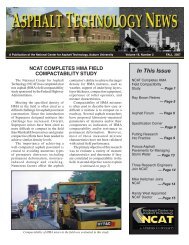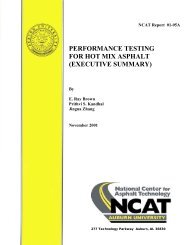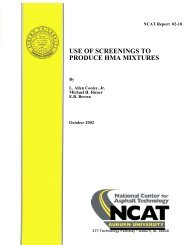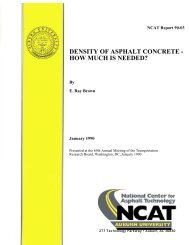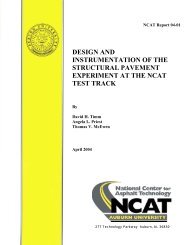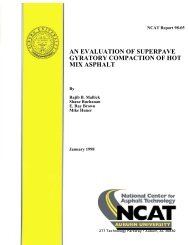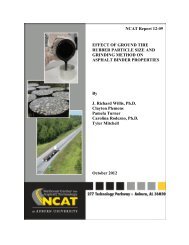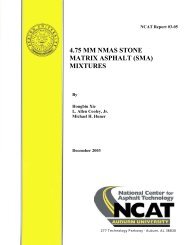<strong>Asphalt</strong> Forum ResponsesThe following responses have been received to questions raised inthe Spring 2009 <strong>Asphalt</strong> Forum.81. Has any other state encountered tenderness issueswith warm-mix asphalt (WMA)? In some cases,Kentucky has noted that the WMA mat is tenderduring compaction, resulting in poor density andsmoothness of the finished pavement. Also, the WMApavement may remain tender for several days afterplacement. (Allen Myers, Kentucky TransportationCabinet)Florida Department of Transportation, Greg SholarFDOT has not experienced this.Missouri Department of Transportation, Joe SchroerMissouri has experienced two instances of WMA tendernessoccurring with the Evotherm package. When the mixture wasoverheated to the typical HMA mixing temperature, it shoved andpushed. Also, at cool ambient temperatures, the mixture appearedspongy, as if it would spring back after a roller pass. Eventually forboth situations, compaction was achieved after continued coolingof the mat. It has been noted that when the HMA mix has a temperaturerange with tenderness, the WMA will be spongy in thesame temperature range. At temperatures below that tendernesszone, the WMA compacts normally.Overalll, the WMA seems to set better on the roadway, withless crawling than HMA. One trial project had an HMA section withprofilograph readings indicating a 32 percent improvement in ride,while the WMA section showed a 51 percent improvement in ride.Ohio Department of Transportation, Dave PowersWe have placed more than 15 different WMA mixes withouttenderness. We do, however, think it is a possibility. We restrict waterto 1.8 percent of binder.Oklahoma Department of Transportation, Kenneth Ray HobsonWe have no such experience to date. Perhaps the type of WMAtechnology used might be a factor.Ontario Ministry of Transportation,Kai TamWe are not aware of any cases of tenderness on the WMA trialsconstructed in Ontario. WMA technologies used on a trial basis onprovincial highways in Ontario to date include Evotherm ET andLafarge’s Hypertherm. We also observed paving of Sasobit andEvotherm DAT on municipal roads.Virginia Transportation Research Council, Bill MaupinVirginia has not noticed a tenderness problem with WMA.2. Which states are planning to implement the MultipleStress Creep Recovery (MSCR) test in lieu of their currentmethod of determining modification of binders?Are binder suppliers in favor of this? Missouri wouldlike to see implementation by agencies and suppliersto avoid the questions following a failing test, only tofind out the supplier followed another state’s testingprotocol. (Joe Schroer, Missouri Department of Transportation)Alabama Department of Transportation,Randy MountcastleAlabama is not using the MSCR test at this time.Florida Department of Transportation, Greg SholarFDOT will eventually adopt the MSCR test but will not do sothis year.Kentucky Transportation Cabinet, Allen MyersThe Kentucky Transportation Cabinet has performed some informationalMSCR testing on typical asphalt binders, but we haveno immediate plans to implement this technology. Any future effortsto implement the MSCR specification will certainly includecoordination with the liquid asphalt industry.Nevada Department of Transportation, Darin TedfordWhile we have run the MSCR test for research purposes, we donot plan to implement it in our specifications.New Hampshire Department of Transportation, Denis BoisvertNew Hampshire is interested in the MSCR test and is participatingin the Pooled Fund Project.Ohio Department of Transportation, Dave PowersOhio is researching the MSCR test. Suppliers are pushing it,although some do not have equipment that can easily perform thetest. We have advised them to replace equipment within the year.In general, our elastic recovery (ER) test has worked well for us, sowe are not in a hurry.Oklahoma Department of Transportation, Kenneth Ray HobsonWe have no plans to implement the MSCR test, nor do wehave experience using it to date. However, it is something that wewould like to investigate. The main PG+ specification that we usefor polymer-like characteristics is the elastic recovery test, ASTMD6084. Our limits for PG 64-22 OK, PG 70-28 OK and PG 76-28OK, respectively, are none, ≥ 65 and ≥ 75.Ontario Ministry of Transportation, Kai TamWe are currently looking into applications of the MSCR test.We have not yet made a decision regarding the adoption of thistest, nor have we yet consulted with the industry.Tennessee Department of Transportation, Mark WoodsTDOT has recently acquired the equipment to perform theMSCR test for the purpose of evaluating it in-house, but TDOTdoes not intend to implement it as a specification anytime in thenear future.Virginia Transportation Research Council, Bill MaupinVirginia has only used the MSCR test in experimental testing andlimited monitoring. There are no plans to implement it at this time.<strong>Asphalt</strong> <strong>Technology</strong> <strong>News</strong>
Specification CornerAlabamaAlabama is allowing warm mix asphalt (WMA) at the contractor’soption, with the exception of high volume roads and stonematrix asphalt (SMA) mixes. When WMA is used, the mix maycontain a maximum of 35 percent recycled material. The recycledmaterial may consist entirely of recycled asphalt pavement (RAP);alternatively, a combination of RAP and recycled asphalt shingles(RAS) may be used. Up to 5 percent factory waste shingles or 3percent used roof shingles are allowed.Alabama is also allowing 12 percent ground tire rubber (GTR) tobe used as an alternative to traditional PG 76-22 for high volumeroadways with Superpave mixes. GTR will not be allowed in SMAmixes. We have not had any contractors try this yet.FloridaFlorida is implementing the use of WMA at the choice of thecontractor. This is proceeding well, with no issues to date.Florida will allow 20 percent RAP in mixtures containing PG76-22 binder as well as 20 percent RAP in dense-graded frictioncourse mixtures.The required method of calibration for the gyratory compactoris changing from external angle to internal angle. This implementationis proceeding with minimal issues.KentuckyAs reported in the Spring 2009 issue, the Kentucky TransportationCabinet has revised its specifications to permit WMA produced bythe water-injection/foaming process at the contractor’s option. Inconjunction with local FHWA personnel, we have recently developeda policy for evaluating other WMA technologies. The newpolicy provides instructions for manufacturers or suppliers of WMAprocesses or products to follow when requesting evaluation of aparticular WMA technology. The policy also specifies the informationto be collected and testing to be performed on the associatedWMA trial projects, as well as the WMA pavement performancecharacteristics that will be monitored in the future.New HampshireThis spring, we overhauled our entire Division 400 specificationsfor bituminous materials. The major impacts of those changes are:• Return control of the asphalt plants to the HMA producers formethod specification work. DOT staff had been in control ofthe plant changes for many years. This change reduces theneed for DOT inspectors to cover these operations and makesthe specification more like its QC/QA counterpart.• Control the RAP content by measuring total reused binder(TRB). This gives us better control of the used binder in ourmixes, since the asphalt content in RAP sources in our statecan vary from 3 to 6 percent.• Increase the allowed RAP usage in HMA before requiring abump in virgin binder grade or pre-production testing. Assuminga 4 percent asphalt content in the RAP source, wenow allow up to 20 percent RAP in both wearing and basecourses before PG grade verification is required. That is equivalentto 1.0 percent TRB under our new specification.• Allow a maximum of 1.5 percent TRB (37.5 percent RAP) inFall 2009 • Vol. 21 • No. 2base and binder courses with testing requirements.• Introduction of RAS product. Previously silent on this material,our specification now allows it in quantities of up to 0.6percent of the mix. The RAS product binder is inclusive in theTRB, meaning a mix with 1.0 percent TRB and 0.6 percentRAS product could only contain 0.4 percent RAP binder. RASproducts are to be qualified under DOT criteria.OhioWe are allowing WMA in all base courses, as well as allintermediate and low-traffic surface courses.OklahomaOur new Standard Specifications will be published this year.One of the changes is a reduction in the maximum limit for flashpoint, AASHTO T 48, from 550°F to 500°F. Our current PG+ Specificationsincreased the flash point to eliminate poorly performingbinders, but those problem binders are no longer in production.WMA mix designs may be used as an alternative to our standardHMA mix designs.We have added Hamburg Rut Testing to replace the <strong>Asphalt</strong>Pavement Analyzer (APA) testing for new asphalt mix designs.For Hamburg testing at 122°F, the minimum number of passesrequired to reach a rut depth of 0.5 inch are 10,000 for PG 64-22OK, 15,000 for PG 70-28 OK and 20,000 for PG 76-28 OK.We have added a new Special Provision to crush and screenRAP into coarse and fine stockpiles. One pile or both may be usedin the mix. For binder courses with PG 64-22 OK, up to 25 percentRAP may be used. For binder courses with PG 70-28 OK and PG76-28 OK, up to 15 percent RAP may be used. For temporary construction,up to 35 percent RAP may be used.OntarioThe Ontario Ministry of Transportation is making the followingspecification changes:• Special Provision 103F31Modified – Smoothness by InertialProfilers. An MTO/Industry task group was set up in 2007 toinvestigate how MTO can begin the transition from QC acceptancebased on PI measurements by California Profilographto QA acceptance based on IRI and localized roughness measurementsby inertial profiler. A Non-Standard Special Provision,a new Laboratory Standard for calibrating, correlatingand taking measurements with inertial profilers, and a list ofequipment requirements for inertial profilers have been created.During the 2009 construction season, MTO is planningto implement these new specifications in selected contracts.• Special Provision – Increased RAP Usage. We have revisedour specifications to permit greater percentages of RAP in ourmixes. RAP and roof shingle tabs (RST) are now permitted inall hot mix asphalt courses, including premium surfaces courseswith the exception of SMA mixes. Up to 20 percent RAPis permitted in all surface courses excluding SMA. For bindercourses within 150 mm of the pavement surface for facilitiescarrying more than 3 million ESALs over the 20-year designlife, up to 20 percent RAP is permitted. For all other bindercourses, up to 40 percent RAP is permitted. Up to 3 percent9




